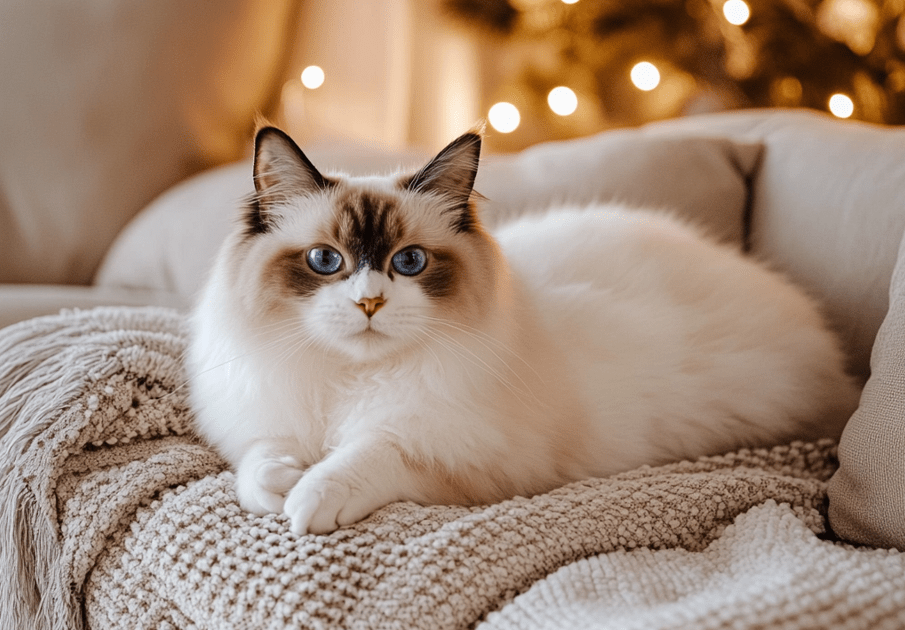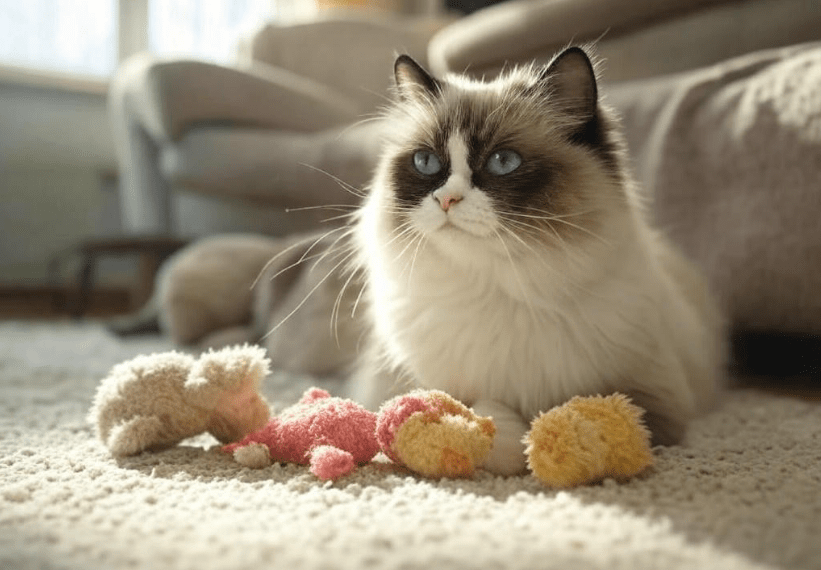
Ragdoll cats, with their striking blue eyes and plush coats, are beloved for their docile and affectionate nature. However, keeping these gentle felines mentally and physically stimulated is essential for their well-being. DIY enrichment activities for Ragdoll cats provide an affordable way to engage their curious minds and playful spirits. This article explores five budget-friendly, creative projects to enrich your Ragdoll’s environment, ensuring they stay happy and healthy without breaking the bank. From homemade toys to interactive games, these ideas are tailored to suit the unique traits of Ragdoll cats.
Why Enrichment Matters for Ragdoll Cats
Ragdolls are known for their laid-back personalities, often described as “puppy-like” due to their tendency to follow their owners around and flop into relaxed postures. However, their calm demeanor doesn’t mean they don’t need stimulation. Without proper enrichment, Ragdolls can become bored, leading to stress, lethargy, or even destructive behaviors like scratching furniture.
Enrichment activities stimulate a cat’s natural instincts to hunt, explore, climb, and play. For Ragdolls, who may not be as high-energy as breeds like Bengals, enrichment should focus on gentle play, mental challenges, and sensory engagement. DIY solutions are perfect because they allow you to customize activities to your cat’s preferences while keeping costs low.
Benefits of DIY Enrichment for Ragdoll Cats
Creating DIY enrichment activities for Ragdoll cats offers several advantages:
Cost-Effective: Most projects use household items, reducing the need for expensive store-bought toys.
Customizable: Tailor activities to your Ragdoll’s personality, whether they love chasing, pouncing, or solving puzzles.
Bonding Opportunity: Crafting and playing with your cat strengthens your relationship.
Sustainability: Repurpose materials like cardboard or fabric, making eco-friendly choices.
Variety: Rotate homemade toys to keep your Ragdoll engaged over time.
With these benefits in mind, let’s dive into five DIY enrichment activities designed specifically for Ragdoll cats.
1. Cardboard Box Puzzle Maze
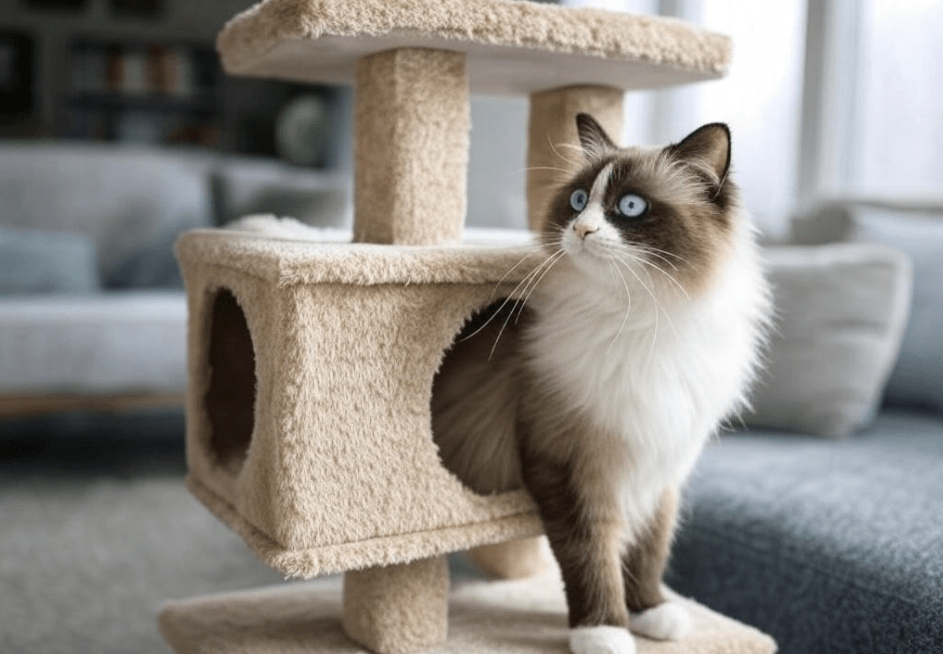
Why It’s Great for Ragdolls
Ragdolls love cozy spaces and gentle exploration. A cardboard box maze taps into their curiosity while providing a safe, enclosed environment for play. This activity encourages problem-solving and physical activity without overwhelming their calm nature.
Materials Needed
1.Several cardboard boxes (e.g., shipping boxes or shoeboxes)
2.Scissors or box cutter
3.Non-toxic glue or tape
4.Treats or small toys
5.Optional: Catnip or crinkle paper
Instructions
Collect Boxes: Gather 3–5 cardboard boxes of varying sizes. Ensure they’re clean and free of staples or sharp edges.
Cut Openings: Create doorways, tunnels, and windows by cutting holes in the boxes. Make some openings large enough for your Ragdoll to pass through and others small for paw exploration.
Connect the Boxes: Arrange the boxes in a maze-like structure. Secure them with non-toxic glue or tape to prevent collapsing.
Add Enrichment: Place treats, small toys, or a sprinkle of catnip inside to entice exploration. Crinkle paper adds a sensory element.
Introduce Your Cat: Place the maze in a familiar area and let your Ragdoll explore at their own pace. Encourage them with gentle praise or a feather toy.
Tips
1.Rotate the maze’s layout weekly to maintain interest.
2.Add soft blankets inside for Ragdolls who love lounging.
3.Supervise initial play to ensure safety.
Cost
Virtually free if you recycle boxes from deliveries.
2. Feather Wand Teaser Toy
Why It’s Great for Ragdolls
Ragdolls enjoy gentle, interactive play that mimics hunting. A feather wand engages their prey drive without requiring intense physical exertion, making it ideal for their relaxed temperament.
Materials Needed
1.Wooden dowel or stick (12–18 inches long)
2.Cotton or jute string
3.Feathers (real or craft feathers)
4.Small bells (optional)
5.Non-toxic glue or hot glue gun
6.Scissors
Instructions
Prepare the Wand: Use a smooth wooden dowel or repurpose a stick from your yard (sand it to remove splinters).
Attach the String: Cut a 2–3-foot piece of string and tie it securely to one end of the dowel. Use a dab of glue to reinforce the knot.
Add Feathers: Tie or glue 3–5 feathers to the other end of the string. Ensure they’re securely attached to withstand playful tugs.
Optional Bells: Attach a small bell to the string for auditory stimulation, which many Ragdolls find intriguing.
Test the Toy: Wave the wand gently to ensure it moves naturally and all components are secure.
How to Use
1.Engage your Ragdoll by dragging the wand across the floor or dangling it in the air.
2.Mimic prey movements, like slow crawls or sudden hops, to keep them interested.
3.Play for 10–15 minutes daily to satisfy their hunting instincts.
Tips
1.Store the wand out of reach to maintain its novelty.
2.Replace feathers as they wear out to keep the toy appealing.
3.Pair with verbal encouragement to make playtime a bonding experience.
Cost
Under $5, using craft supplies or natural materials.
3. Toilet Paper Roll Treat Dispenser
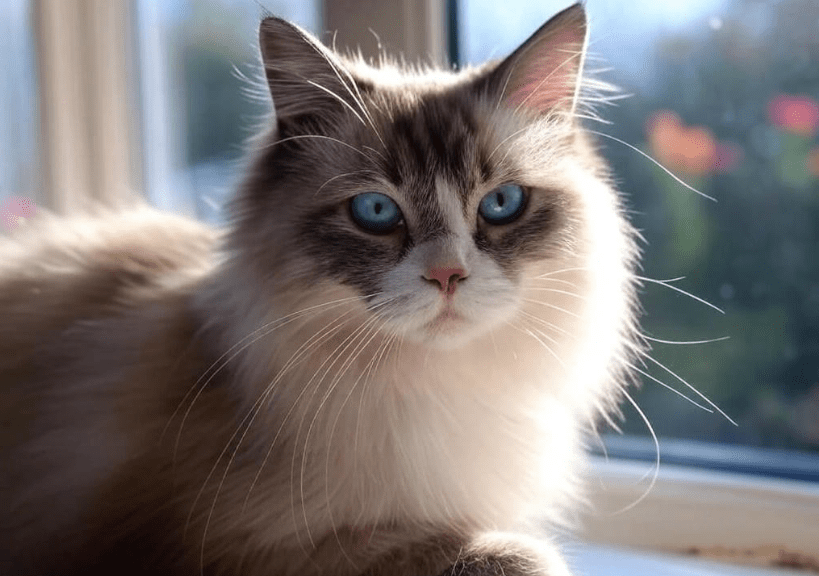
Why It’s Great for Ragdolls
Mental stimulation is key for Ragdolls, who enjoy low-key challenges. A treat dispenser made from toilet paper rolls encourages problem-solving and rewards their efforts with tasty treats.
Materials Needed
1.3–5 empty toilet paper rolls
2.Small treats or kibble
3.Non-toxic glue
4.Scissors
5.Optional: Colored paper or paint for decoration
Instructions
Clean the Rolls: Ensure toilet paper rolls are free of residue.
Create the Dispenser: Fold one end of each roll to close it, forming a small container. Leave the other end open.
Combine Rolls: Glue 3–5 rolls together in a pyramid or cluster shape, with open ends facing outward.
Add Treats: Place small treats or kibble inside each roll. For added challenge, partially close the open ends with a small flap.
Decorate (Optional): Wrap the rolls in colored paper or paint with non-toxic materials for visual appeal.
How to Use
1.Place the dispenser on the floor and let your Ragdoll bat it around to release treats.
2.Start with easy access to treats, then increase difficulty by tightening the flaps.
3.Refill periodically to keep the activity engaging.
Tips
1.Use treats your Ragdoll loves to motivate them.
2.Supervise to ensure they don’t chew the cardboard excessively.
3.Combine with a play session to make it part of a routine.
Cost
Free, using household items.
4. Fabric Scrap Sensory Mat
Why It’s Great for Ragdolls
Ragdolls are sensitive to textures and love soft surfaces. A sensory mat made from fabric scraps stimulates their sense of touch and encourages exploration, doubling as a cozy resting spot.
Materials Needed
1.Old T-shirts, towels, or fabric scraps
2.Scissors
3.Needle and thread or fabric glue
4.Optional: Catnip, crinkle material, or small toys
Instructions
Cut Fabric: Cut fabric scraps into strips or squares (4–6 inches each).
Create the Base: Use a large piece of fabric (e.g., an old towel) as the mat’s base.
Attach Textures: Sew or glue fabric strips onto the base in a patchwork pattern. Vary textures (e.g., cotton, fleece, denim) for sensory variety.
Add Extras: Sew small pockets to hide treats or catnip. Include crinkle material or a squeaky toy for auditory stimulation.
Secure Edges: Fold and sew the base’s edges to prevent fraying.
How to Use
1.Place the mat in a quiet area where your Ragdoll likes to relax.
2.Encourage exploration by sprinkling catnip or hiding treats in the pockets.
3.Use as a lounging spot during cuddle time.
Tips
1.Wash the mat regularly to keep it fresh.
2.Rotate hidden items (e.g., treats or toys) to maintain interest.
3.Pair with a window perch for a multi-sensory experience.
Cost
Free if using old clothes or linens.
5. Paper Bag Obstacle Course
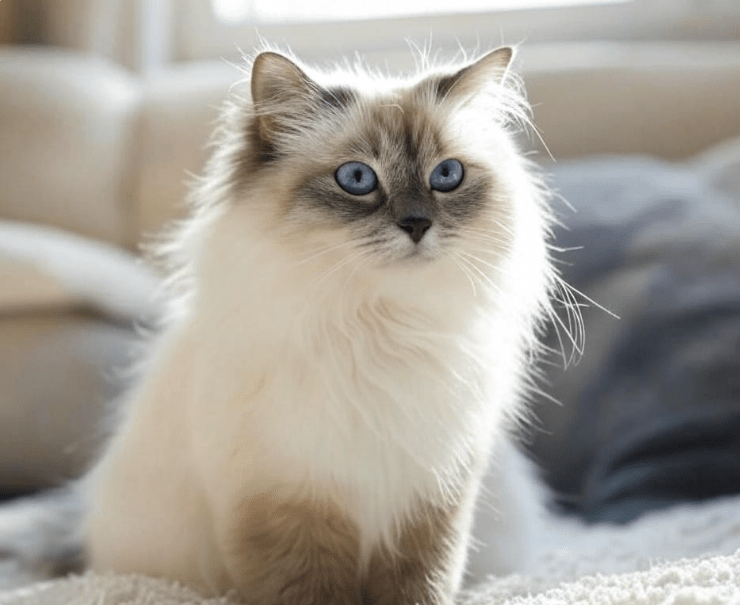
Why It’s Great for Ragdolls
Ragdolls enjoy low-intensity exploration, and paper bags provide a rustling, interactive environment. An obstacle course made from bags encourages gentle physical activity and satisfies their love for hiding.
Materials Needed
1.5–7 paper grocery bags
2.Scissors
3.Treats or toys
4.Optional: Catnip or string
Instructions
Prepare Bags: Ensure bags are clean and free of handles or staples.
Cut Openings: Create tunnels by cutting the bottoms off some bags and taping them together. Leave others intact as hiding spots.
Set Up the Course: Arrange bags in a path or cluster, with some open for crawling and others closed for hiding.
Add Incentives: Place treats, toys, or a sprinkle of catnip inside to encourage exploration.
Test Stability: Ensure the course is stable and won’t collapse during play.
How to Use
1.Guide your Ragdoll through the course with a toy or verbal encouragement.
2.Let them explore at their own pace, as Ragdolls prefer low-pressure play.
3.Rearrange the bags weekly to keep the course fresh.
Tips
1.Supervise to prevent chewing or getting stuck.
2.Add a feather wand to make the course more interactive.
3.Store bags flat when not in use to save space.
Cost
Free, using grocery bags.
Additional Tips for Ragdoll Enrichment
Rotate Activities: Alternate these DIY projects to prevent boredom. Ragdolls thrive on variety but don’t need constant high-energy play.
Incorporate Routine: Schedule 10–15 minutes of enrichment daily, ideally before meals to mimic hunting.
Observe Preferences: Some Ragdolls prefer mental challenges, while others love physical play. Tailor activities to their personality.
Safety First: Always use non-toxic materials and supervise new activities to ensure your cat’s safety.
Combine with Bonding: Use these activities to strengthen your bond, as Ragdolls are highly social and love attention.
Why Ragdolls Benefit from Budget-Friendly Enrichment
Ragdolls are unique in their need for gentle, consistent stimulation that respects their calm nature. Unlike more active breeds, they don’t require elaborate setups or expensive toys. DIY enrichment activities for Ragdoll cats allow owners to provide tailored, engaging experiences using everyday materials. These projects not only save money but also foster creativity and deepen the bond between you and your feline companion.
By focusing on sensory, mental, and physical stimulation, these five activities address the core needs of Ragdolls while keeping their environment dynamic and fun. Whether it’s a cardboard maze or a sensory mat, each project is designed to spark joy and curiosity in your Ragdoll’s daily life.
Conclusion

Keeping your Ragdoll cat entertained doesn’t have to be expensive or complicated. With these DIY enrichment activities for Ragdoll cats, you can create a stimulating environment that caters to their unique personality and instincts. From cardboard mazes to feather wands, these budget-friendly projects offer endless opportunities for play, exploration, and bonding. Try one or all of these ideas to see which your Ragdoll loves most, and watch them thrive in a world of homemade fun.
By investing a little time and creativity, you’ll provide your Ragdoll with the enrichment they need to live a happy, healthy life—all while keeping your wallet happy too.


